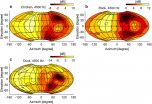Youngest bone marrow transplant patients at higher risk of cognitive decline
St. Jude Children's Research Hospital study identifies small group of patients at risk for intellectual decline after bone marrow transplantation; results set stage for new strategies to preserve IQ and fight cancer
2014-12-11
(Press-News.org) (MEMPHIS, Tenn. - December 11, 2014) Toddlers who undergo total body irradiation in preparation for bone marrow transplantation are at higher risk for a decline in IQ and may be candidates for stepped up interventions to preserve intellectual functioning, St. Jude Children's Research Hospital investigators reported. The findings appear in the current issue of the Journal of Clinical Oncology.
The results clarify the risk of intellectual decline faced by children, teenagers and young adults following bone marrow transplantation. The procedure is used for treatment of cancer and other diseases. It involves replacing the patient's own blood-producing stem cells with those from a healthy donor.
Researchers tracked IQ scores of 170 St. Jude patients before and for five years after transplantation, making this the most comprehensive effort yet to determine how the procedure affects intelligence. The patients ranged in age from 4 months to 23 years when their transplants occurred. The procedure had little lasting impact on the IQ scores of most patients.
"For the great majority of patients, these findings provide reassurance that transplantation will not have a significant negative impact on cognitive development," said corresponding author Sean Phipps, Ph.D., chair of the St. Jude Department of Psychology. "We have also identified a high-risk group of younger patients who may benefit from more intensive interventions, including developmental stimulation and other rehabilitative therapies designed to prevent a decline in intellectual functioning and aid in recovery."
The high-risk group includes patients whose transplants occurred when they were aged 3 years or younger and involved total body irradiation (TBI). TBI is used to prepare patients for transplantation by killing remaining cancer cells and protecting the transplanted cells from their immune systems. TBI is associated with a range of short-term and long-term side effects. At St. Jude, therapeutic advances have significantly reduced the use of TBI in bone marrow transplantations.
Previous studies of bone marrow transplantation survivors reported conflicting results about the long-term impact of age and TBI on cognitive abilities.
Before transplantation, the average IQ scores of all patients in this study were in the normal range. One year after transplantation, average IQ scores of patients aged 5 and younger had declined sharply. But scores of most patients rebounded in subsequent years. Five years after the procedure, IQ scores for most patients, even the youngest survivors, had largely recovered and fell within the range of normal intelligence.
Patients in the high-risk group were the lone exception. IQ scores of patients who were both aged 3 or younger when their transplants occurred and who received TBI failed to recover from the first-year decline. Five years after transplantation, these survivors had average IQ scores in the low-normal range of intelligence. Their scores were more than 16 points lower than the scores of patients who were just as young when their transplants occurred but did not receive TBI.
Of the 72 patients in this study whose transplants included TBI, researchers found there was a long-term impact on intellectual functioning only of patients who were aged 3 or younger at transplantation.
"The significant first-year decline reflects the intensity of transplantation, which our results suggest leads to greater disruption in development in the youngest children than was previously recognized," said the study's first author Victoria Willard, Ph.D., a St. Jude psychology department research associate.
These findings are good news for most parents whose children must undergo transplantation and provide another reason for hope of good long-term outcomes. For those whose children are in the newly recognized high-risk group, increased attention and activities designed to stimulate cognitive development may help to prevent reduced IQ following transplantation, Phipps said.
INFORMATION:
The other authors are Wing Leung, M.D., Ph.D., Qinlei Huang and Hui Zhang, all of St. Jude.
The research was supported in part by a grant (CA60616) from the National Institutes of Health and ALSAC
St. Jude Media Relations Contacts
Carrie Strehlau
desk (901) 595-2295
cell (901) 297-9875
carrie.strehlau@stjude.org
Summer Freeman
desk (901) 595-3061
cell (901) 297-9861
summer.freeman@stjude.org
St. Jude Children's Research Hospital
St. Jude Children's Research Hospital is leading the way the world understands, treats and cures childhood cancer and other life-threatening diseases. It is the only National Cancer Institute-designated Comprehensive Cancer Center devoted solely to children. Treatments developed at St. Jude have helped push the overall childhood cancer survival rate from 20 percent to 80 percent since the hospital opened more than 50 years ago. St. Jude is working to increase the overall survival rate for childhood cancer to 90 percent in the next decade. St. Jude freely shares the breakthroughs it makes, and every child saved at St. Jude means doctors and scientists worldwide can use that knowledge to save thousands more children. Families never receive a bill from St. Jude for treatment, travel, housing and food--because all a family should worry about is helping their child live. To learn more, visit stjude.org or follow St. Jude at @stjuderesearch.
ELSE PRESS RELEASES FROM THIS DATE:
2014-12-11
University of Rochester researchers believe they're on track to solve the mystery of weight gain - and it has nothing to do with indulging in holiday eggnog.
They discovered that a protein, Thy1, has a fundamental role in controlling whether a primitive cell decides to become a fat cell, making Thy1 a possible therapeutic target, according to a study published online this month by the FASEB Journal.
The research brings a new, biological angle to a problem that's often viewed as behavioral, said lead author Richard P. Phipps, Ph.D. In fact, some diet pills consist of ...
2014-12-11
New Rochelle, NY, December 11, 2014--In cases of traumatic brain injury (TBI), predicting the likelihood of a cranial lesion and determining the need for head computed tomography (CT) can be aided by measuring markers of bone injury in the blood. The results of a new study comparing the usefulness of two biomarkers released into the blood following a TBI are presented in Journal of Neurotrauma, a peer-reviewed journal from Mary Ann Liebert, Inc., publishers. The article is available free on the Journal of Neurotrauma website at http://online.liebertpub.com/doi/full/10.1089/neu.2013.3245 ...
2014-12-11
MAYWOOD, Il. - Riding a couple roller coasters at an amusement park appears to have triggered an unusual stroke in a 4-year-old boy, according to a report in the journal Pediatric Neurology.
The sudden acceleration, deceleration and rotational forces on the head and neck likely caused a tear in the boy's carotid artery. This tear, called a dissection, led to formation of a blood clot that triggered the stroke, Loyola University Medical Center neurologist Jose Biller, MD and colleagues report.
Strokes previously have been reported in adult roller coaster riders, but ...
2014-12-11
Worcester, Mass. - A new statistical model developed by a research team at Worcester Polytechnic Institute (WPI) may enable physicians to create personalized cancer treatments for patients based on the specific genetic mutations found in their tumors.
Just as cancer is not a single disease, but a collection of many diseases, an individual tumor is not likely to be comprised of just one type of cancer cell. In fact, the genetic mutations that lead to cancer in the first place also often result in tumors with a mix of cancer cell subtypes.
The WPI team developed a new ...
2014-12-11
The once mighty super typhoon has weakened to a depression in the South China Sea as it heads for a final landfall in southern Vietnam. NASA's Aqua satellite captured an image of the storm that showed it was weakening.
NASA's Aqua satellite passed over Hagupit on Dec. 11 at 05:20 UTC (12:20 a.m. EST) and the MODIS instrument captured a visible image of the storm. The MODIS image showed that the thunderstorms had become fragmented around the circulation center.
On Dec. 11 at 1500 UTC (10 a.m. EST) Tropical Depression Hagupit's maximum sustained winds dropped to 30 knots ...
2014-12-11
San Antonio -- December 11, 2014 -- Southwest Research Institute (SwRI) is preparing to unveil a new, miniature portable solar observatory for use onboard a commercial, manned suborbital spacecraft. The SwRI Solar Instrument Pointing Platform (SSIPP) will be on exhibit at the fall meeting of the American Geophysical Union (AGU), Dec. 16-19, at the Moscone Center in San Francisco, Calif.
Using reusable suborbital commercial spacecraft for the SSIPP development effort improves on a traditional space instrument development process that goes back to the dawn of the space ...
2014-12-11
DARIEN, IL - A new study shows that paid work time is the primary waking activity exchanged for sleep and suggests that chronic sleep loss potentially could be prevented by strategies that make work start times more flexible.
Results show that work is the dominant activity exchanged for less sleep across practically all sociodemographic categories. Compared to normal sleepers, short sleepers who reported sleeping 6 hours or less worked 1.55 more hours on weekdays and 1.86 more hours on weekends or holidays, and they started working earlier in the morning and stopped working ...
2014-12-11
December 11, 2014 - Hospitals with robotic surgical systems are more likely to perform "nephron-sparing" partial nephrectomy--a recommended alternative to removal of the entire kidney--in patients with kidney cancer, reports a study in the December issue of Medical Care. The journal is published by Lippincott Williams & Wilkins, a part of Wolters Kluwer Health.
"Hospital acquisition of the surgical robot is associated with greater proportion of partial nephrectomy, an underutilized, guideline-encouraged procedure," write Dr Ganesh Sivarajan of New York University Langone ...
2014-12-11
An interstellar mystery of why stars form has been solved thanks to the most realistic supercomputer simulations of galaxies yet made.
Theoretical astrophysicist Philip Hopkins of the California Institute of Technology (CalTech) led research that found that stellar activity -- like supernova explosions or even just starlight -- plays a big part in the formation of other stars and the growth of galaxies.
"Feedback from stars, the collective effects from supernovae, radiation, heating, pushing on gas, and stellar winds can regulate the growth of galaxies and explain why ...
2014-12-11
Unlike mammals, birds have no external ears. The outer ears of mammals play an important function in that they help the animal identify sounds coming from different elevations. But birds are also able to perceive whether the source of a sound is above them, below them, or at the same level. Now a research team from Technische Universität München (TUM) has discovered how birds are able to localize these sounds, namely by utilizing their entire head. Their findings were published recently in the PLOS ONE journal.
It is springtime, and two blackbirds are having ...
LAST 30 PRESS RELEASES:
[Press-News.org] Youngest bone marrow transplant patients at higher risk of cognitive decline
St. Jude Children's Research Hospital study identifies small group of patients at risk for intellectual decline after bone marrow transplantation; results set stage for new strategies to preserve IQ and fight cancer




